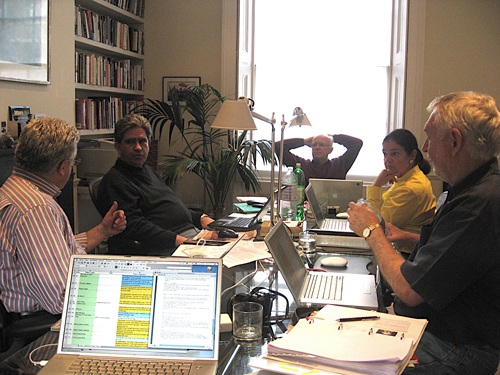81. War Rooms
,
The project is centered through the use of a dedicated war room.
Each year, we come across a scant dozen-or-so projects that have dedicated war rooms, with work products decorating the walls and project members interacting in the project’s common space. While this is hardly a major trend, it is a pattern that is worth analyzing, as such projects tend to be hell-bent for success.
I’m beginning to think that a project not worth a war room may be a project not worth doing.
—TDM
The war room is a manifestation of an attitude that a substantial amount of face-to-face interaction is essential to project success. In addition, it asserts that the active display of work products and artifacts is essential to both the jelling of the team and the conduct of its work. Finally, it is clear evidence of someone’s willingness to invest aggressively in project success. Real estate is the prototypical form of investment, and a project that is allocated real estate possesses a powerful symbol that it matters.
In most cases, the war room is simply a commandeered conference room. The room is large enough to accommodate any or all of the project team members, with room for a few visitors. Typically, project members are in and around the war room at some time most days, and it is there that they conduct most of the key interface discussions and design and redesign sessions.
Artifacts that are on permanent display include deliverables in progress, the working design, the schedule, PERT and manpower-loading charts, risk lists, work breakdown structure, a mix of work products, and managerial artifacts. Team members gravitate to the war room whenever they’re inclined to put their hands on any of the major planning or design artifacts, as well as to view the contributions of their teammates. (There is more on this phenomenon in Pattern 75, “Fridge Door.”) In the best cases, individual workers have private work space adjacent to the war room, so that the room and its surroundings constitute a well-defined project domain.
The project manager is a frequent occupant of the war room. It is there that he maintains the pulse of the project. Since some of the artifacts and work products on display are the manager’s, analyzing and updating them are war room tasks that naturally accrue to the manager.
The following may be obvious, but it’s still worth stating: Just declaring that the project has a war room and setting space aside for it doesn’t do the trick. The challenge is to make the war room a vital and organic part of the project. The war room has to emerge as part of the project’s own chosen direction; that is the only way the war room is going to be magical, as war rooms can sometimes be.
